- Indico style
- Indico style - inline minutes
- Indico style - numbered
- Indico style - numbered + minutes
- Indico Weeks View
27th International Conference on Nonlinear Elasticity in Materials
→
Europe/Berlin
Neustadt an der Weinstrasse
Neustadt an der Weinstrasse
Contact
-
-
18:00
→
19:00
Dinner 1h Speisesaal
Speisesaal
-
20:00
→
21:30
Icebreaker 1h 30m Pfälzerkeller
Pfälzerkeller
-
18:00
→
19:00
-
-
07:00
→
09:00
Breakfast 2h Speisesaal
Speisesaal
-
09:00
→
09:10
Welcome and conference scope Aula
Aula
-
09:00
Welcome and conference scope 10m
-
09:00
-
09:10
→
10:20
Time-dependent nonlinear effects: I Aula
Aula
-
09:10
Fast and slow dynamic effects in Nonlinear Resonant Ultrasound Spectroscopy 35m
Nonlinear Resonant Ultrasound Spectroscopy (NRUS) is a fundamental technique for assessing elastic nonlinearity in materials, particularly those exhibiting elastic hysteresis. Such materials are also known to exhibit fast and slow dynamic response, which is evolving in time. In this study, we examine the interplay between slow and fast dynamic effects in NRUS measurements performed on a sandstone rectangular beam excited at its first longitudinal mode.
To that purpose, we used Dynamic Acousto-Elastic Testing (DAET) to monitor velocity variations at the specimen’s center during a complete run of NRUS probing. NRUS measurements were conducted using sine-train signals sweeping across resonance peaks while alternating between high and baseline amplitudes to facilitate "instantaneous" baseline tracking. The results confirm that the NRUS probing creates a sequence of conditioning and relaxation events, which, in part, accumulate during the run of the experiment. This effect is responsible for possible variation of NRUS curves depending on measurement procedure and for observed “hysteresis” when increasing and decreasing branches of NRUS curves are compared.
A theoretical model is proposed to describe these effects, attributing them to material defects relaxing at different time scales. It achieves a qualitative agreement with experimental results, using solely multi-relaxation components. As a consequence, material characterization methods should be updated to consider these effects, including the definition of quantitative material parameters, as current methods are, to some extent, subject to systematic error, due to cumulative effects.
Work supported by the Ministry of Education, Youth, and Sports of the Czech Republic via the project No. CZ.02.01.01/00/23_020/0008501 (METEX), co-funded by the European Union, and Grant. No. TM04000065.Speaker: Jan Kober (Institute of Thermomechanics of the Czech Academy of Sciences) -
09:45
Influence of Loading Frequency on the Fatigue Life of Concrete 35m
Concrete structures such as bridges and wind turbine towers are subjected to a significant number of load cycles throughout their service life. This repeated loading leads to progressive damage accumulation, commonly referred to as fatigue degradation. The evolution of fatigue damage in concrete is influenced not only by the amplitude of the applied stress or strain but also by the frequency of the cyclic loading. Previous studies have shown that such dependencies are characteristic of nonlinear micro-inhomogeneous solids, including rocks and soft metals, where both amplitude and frequency strongly affect damage mechanisms. In our investigations, experimental observations of the evolution of nonlinear acoustic parameters and the shape of hysteretic stress-strain loops during fatigue testing confirm that similar dependencies are also present in plain concrete under compressive fatigue loading.
A central challenge is to understand how the evolution of nonlinear acoustic parameters and the morphology of hysteresis loops correlate with the fatigue resistance of concrete. Additionally, it is crucial to examine what insights these observations provide into the physical mechanisms underlying damage initiation and progression in concrete. Identifying these relationships may enable more accurate prediction of fatigue life and offer structural indicators for early damage detection.
To investigate this, fatigue tests were conducted on concrete specimens at various loading frequencies. During these tests, both the nonlinear acoustic parameters and the evolution of the hysteresis loops were continuously monitored. A novel aspect of the experimental approach lies in integrating principles from dynamic acoustoelastic testing (DAET) into the fatigue testing protocol. In this context, the cyclic mechanical loading imposed by the testing machine is interpreted as the "pump" wave, while ultrasonic measurements using longitudinal (P) and shear (S) waves function as the "probe" waves. This method facilitates the measurement of acoustic nonlinearity during fatigue degradation. Additional standalone acoustoelastic tests were carried out to validate and compare the evolution of the nonlinear parameters under quasi-static, non-fatigue conditions.
The experimental results show that the fatigue loading frequency significantly affects both the trajectory of nonlinear parameter evolution and the shape of the hysteresis loops. Specimens subjected to the same loading amplitude but different frequencies displayed distinct nonlinear responses and damage accumulation paths. These findings suggest that frequency influences not only the rate of fatigue damage progression but also the dominant underlying damage mechanisms. Based on the experimental results, we propose a physical interpretation model that links the measured nonlinear acoustic parameters to microstructural changes induced by fatigue.
The measured data demonstrate that loading frequency is a critical factor in determining the fatigue resistance of concrete. Furthermore, nonlinear acoustic parameters provide valuable insight into the damage evolution process. The observed correlation between frequency, hysteretic behavior, and nonlinear elasticity supports the use of acoustic nonlinearity as a sensitive damage indicator for fatigue assessment. A better understanding of how concrete responds to different loading frequencies can also contribute to the development of more fatigue-resistant concrete mixes.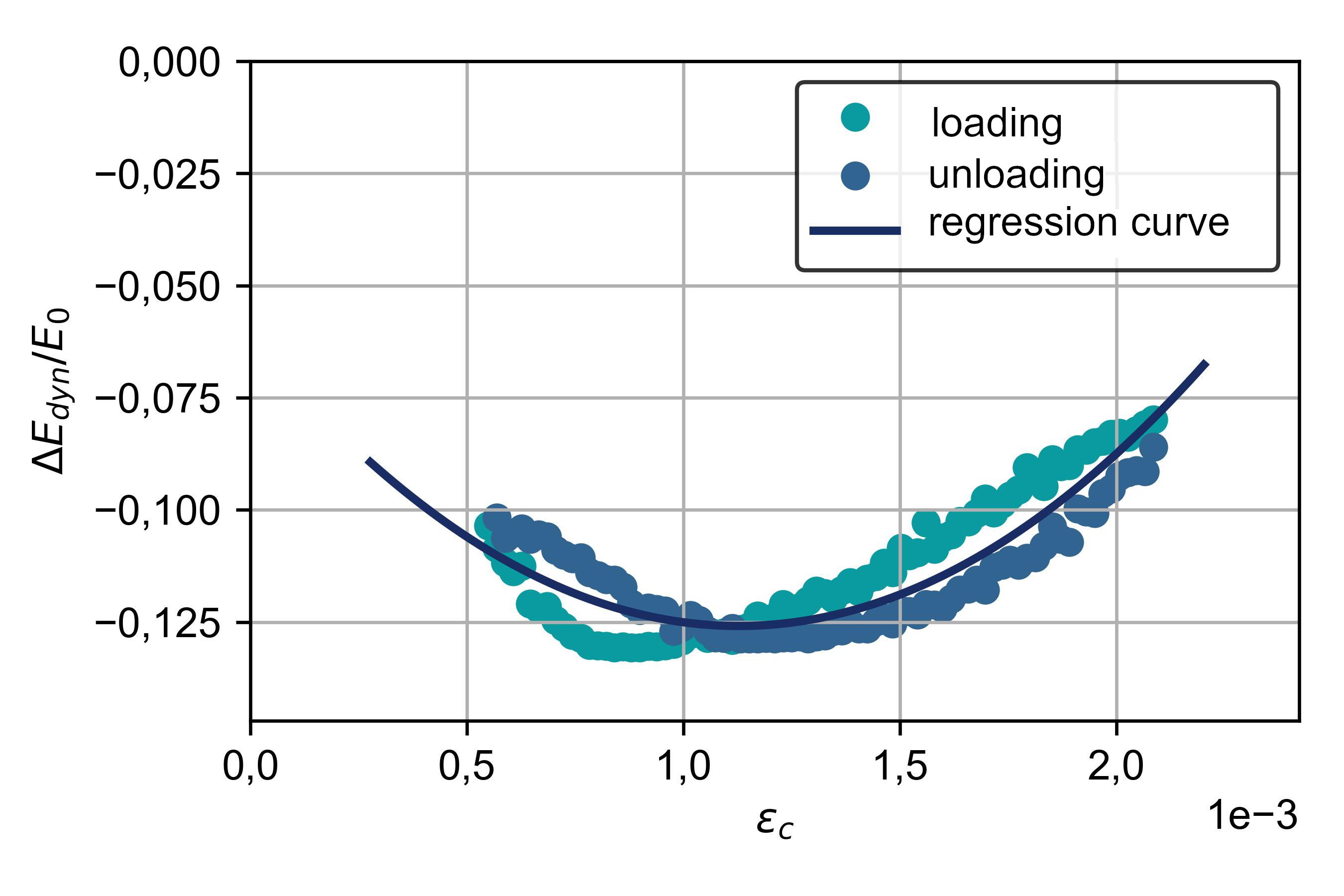
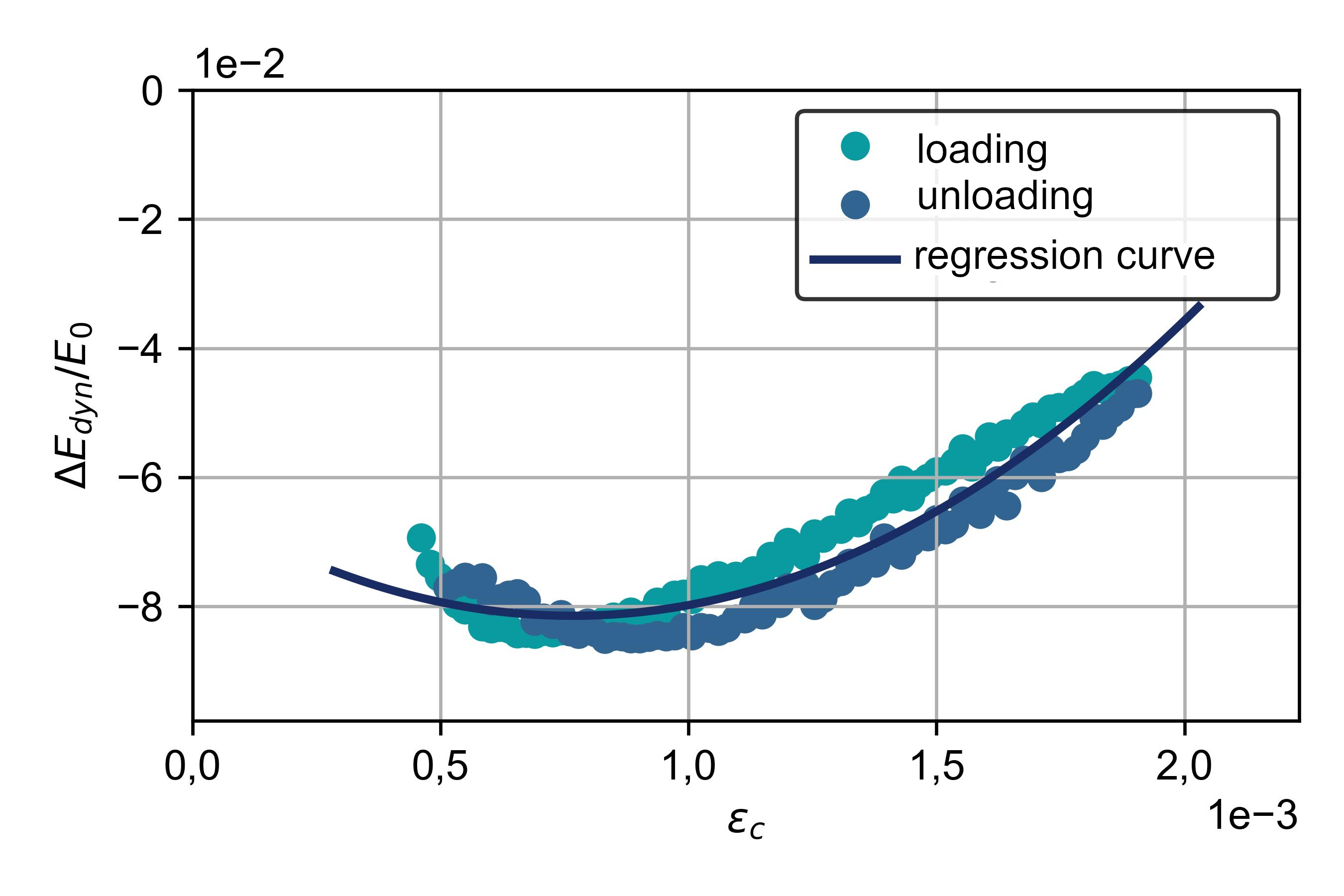 Speaker: Raul Enrique Beltran Gutierrez (Institut für Massivbau - Technische Universität Dresden)
Speaker: Raul Enrique Beltran Gutierrez (Institut für Massivbau - Technische Universität Dresden)
-
09:10
-
10:50
→
12:00
Time-dependent nonlinear effects: II Aula
Aula
-
10:50
Dynamic Acousto-Elastic Testing of Intact and Fractured Westerly Granite 35m
Nonlinear elastic effects are ubiquitous in the Earth’s crust, often revealed by small temporal changes in seismic wave velocity. Being able to interpret these subtle changes is critical to help us assess the state of stress and associated seismic risk. The objective of this work is to unravel the physical mechanisms responsible for the nonlinear elastic response of rocks, and in particular to better understand the role of macroscopic fractures. We perform Dynamic Acousto-Elastic Testing on cylindrical samples of Westerly granite, either intact or with a mated fracture perpendicular to the long-axis. We apply axial and confining stress oscillations of amplitude ±0.5 MPa and 2 min-pump period (frequency f0 ≈ 0.083 Hz), and probe the sample along its long-axis with S-wave, 500-kHz transducers. The quasi-static axial stress is also varied stepwise, between 1 and 17 MPa, both upward then downward, while the confining pressure is kept constant (4 MPa). Dynamic oscillations are conducted at each stress step, and the timing between each oscillation and stress steps is precisely controlled. Each experiment lasts approximately 12 hours. We extract two nonlinear elastic parameters for the received S-wave, as well as for a converted P-wave: R0, the average wave speed change induced by the oscillation, and R1, the wave speed change taking place at the pump frequency f0. The observations for the P-wave and S-waves are similar, with the difference that results for the low-amplitude converted P-wave are noisier. Our preliminary results indicate that counterintuitively, and consistent with a previous study, R1 is smaller for the fractured sample. We also find that R0 is positive (average stiffening) for oscillations taking place when the axial stress is stepped up, and negative (average softening) during down steps. Moreover, this effect is more pronounced for the fractured samples, that is, R0 is larger in absolute value for fractured samples. These results are discussed in the context of previous measurements conducted on fractured rocks.
Speaker: Jacques Riviere (Pennsylvania State University) -
11:25
Effects of pump-induced conditioning on nonlinear coda wave interferometry in concrete 35m
Nonlinear Coda Wave Interferometry (NCWI) is an effective technique for detecting closed cracks in complex materials such as concrete, often missed by conventional linear ultrasonic methods. Combining the sensitivity of Coda Wave Interferometry (CWI) with a nonlinear modulation effect induced by a pump wave, this method activates nonlinearities in materials. Pump waves are conventionally applied in ascending order from smaller to larger amplitudes, and then the relative velocity change at each pump level is plotted against pump amplitude, followed by fitting a quadratic polynomial to the resulting plot. The coefficient of the quadratic term of this fit is ultimately considered an NCWI observable called $\alpha_{\theta}$. Previous NCWI studies have related $\alpha_{\theta}$ to the level of nonlinearity in materials. However, the role of non-equilibrium dynamics—specifically, conditioning effects induced by the pump wave—remains unexplored.
In this study, we investigate how pump-induced conditioning influences NCWI measurements in concrete. Two concrete blocks—one intact and one containing a closed crack—are subjected to a series of controlled laboratory experiments, where we vary the standard pumping parameters. For this purpose, different experiments are carried out, each evaluating the effect of a specific parameter, such as changing the pumping durations or applying the pump levels in reverse order.
Our results show that NCWI observables are indeed sensitive to the specifics of the pumping, indicating that they reflect a combined response due to both material nonlinearity and non-equilibrium effects. In fact, with an increase in the pumping durations, larger relative velocity change values are observed, which indicates a larger share of conditioning effects on the results since the pump amplitude is the same and the only difference is an increase in the duration of pumping. On the other hand, keeping the pump for a relatively long duration or applying it in reverse order from larger to smaller amplitudes leads to smaller relative velocity changes due to pre-conditioning effects.
Nevertheless, across all experiments, the damaged block consistently shows larger values of observables than the intact one, showing that, regardless of the differences in measurements, the method can still distinguish intact and damaged blocks.This work highlights the importance of considering non-equilibrium effects in the interpretation of NCWI results for materials that are affected by non-equilibrium dynamics.
Speaker: Shilan Shaabani (Doctoral Candidate - GERS-GeoEND, Univ Gustave Eiffel, CS5004, F-44344, Bouguenais, France)
-
10:50
-
12:15
→
13:15
Lunch 1h Speisesaal
Speisesaal
-
14:00
→
15:10
Time-dependent nonlinear effects: III Aula
Aula
-
14:00
The coupled impacts of internal relative humidity on both the linear and nonlinear Young’s modulus of siliciclastic sandstones 35m
It is well known that the water saturation degree ($S_w$) can strongly affect the linear viscoelastic properties of siliciclastic sandstones, even at low values (a few % points). For example, the impacts on the linear $Q$ was already studied starting from the end of the ´970s, in relation to lunar samples measured in the lab. A decrease in linear moduli with increasing $S_w$ has been repeatedly documented in the literature. Even the effects on mesoscopic nonlinear properties have been reported by multiple groups in the ICNEM community.
The understanding of the physical controls of such effects gain new importance, as more recent geophysical surveying approaches, e.g., based on seismic ambient noise interferometry, try to take advantage of such effects for monitoring changes in the subsurface’s hydro-geological states due to, e.g., seasonal or long-term droughts, to floods or to geotechnical operations (for example fluid injections).
We report here about a rock physics, lab-scale experimental campaign, which aimed at improving the physical picture of the pore-scale controls. We focused on changes only due to variations in relative humidity (RH), starting from a “dry” state. Thus, we dealt only with low $S_w$ values (a few % points as well). We measured both the linear, complex-valued Young’s modulus and the mesoscopic nonlinear one (only real part thereof) for Berea and Rothbach sandstone specimens conditioned at actual equilibrium states. Here, equilibrium means that the internal and environmental RHs were almost identical, as quantitatively assessed. This is a novelty compared with already published work, especially for nonlinearity results. RH equilibria guarantee the absence of transients due to, e.g., diffusion and/or thin film-flow. They simplify the physical picture of how the moisture is distributed and may interact with the solid skeleton.
We assessed the latter via water vapor sorption and $^1$H nuclear magnetic resonance (NMR) transverse relaxation spectroscopy measurements on sibling specimens. These two techniques allow inferring the type of water (adsorbed vs capillary-condensed vs freely mobile) and its partitioning within parts of the pore space with different size.With increasing RH between 0% and 97% RH, corresponding to a $S_w$ increase between 0% and 4%, the linear Young’s modulus decreased monotonically of up to 30%. The linear wave amplitude attenuation coefficient (proportional to $Q^{-1}$) increased of up to 150%, surprisingly not monotonically. A local minimum occurred at about 45% RH. Interestingly, when comparing with older literature for similar siliciclastic sandstones, such local minimum was already observed but completely not addressed.
The nonlinear Young’s modulus increased of up to about 300%, confirming what already reported in the literature, i.e., a higher sensitivity of the nonlinear moduli than the linear ones to changes in moisture content, even for such small $S_w$ values. No significant hysteresis was observed upon a full adsorption-desorption cycle.
The key novel observation consists in a correspondence between the RH, at which the local minimum in the wave amplitude attenuation coefficient occurred, and the start of the observation of slow dynamics effects (at the frequency change resolution level we could achieve). Below such RH, a classical cubic nonlinear model more accurately describes the data than a mesoscopic one. The vapor sorption as well as the $^1$H NMR data suggest that, at such RH, water is predominantly contained in the smallest pores, e.g., within the cementing mineral phases and in the inter-layer space of clayey minerals. It is mainly present in the form of adsorbed thin films, with a few mono-molecular size, contrary to what proposed in recent articles (i.e., order of 1000 mono-molecular size).
We draw two important conclusions from these results:
(1) a (smooth) transition from a predominant classical to a mesoscopic nonlinear behavior seems to be associated with the continuous thickening of adsorbed water films, thus with capillary condensation;
(2) such smooth transition is characterized by a remarkable local maximum in $Q$ (equivalently, a local minimum in wave amplitude attenuation coefficient), whose physical origins is for us not clear and which is worth of in-depth investigation.
These conclusions suggest that the pore-scale controls of the takeover, by mesoscopic nonlinearity, of the macroscopic nonlinear response and of the changes in the linear elastic one are both related with (I) the surface physics and chemistry properties and (II) the pore space properties specific of the investigated sedimentary rock. This is an hypothesis. If validated extensively on other sedimentary rock types, it would mean that a reliable interpretation of the changes in the subsurface’s nonlinear elastic response to changes in its saturation state could and should not abstract from the mineralogical, textural and pore-scale properties of the probed geologic formation. Any universal interpretation would not be reliable.
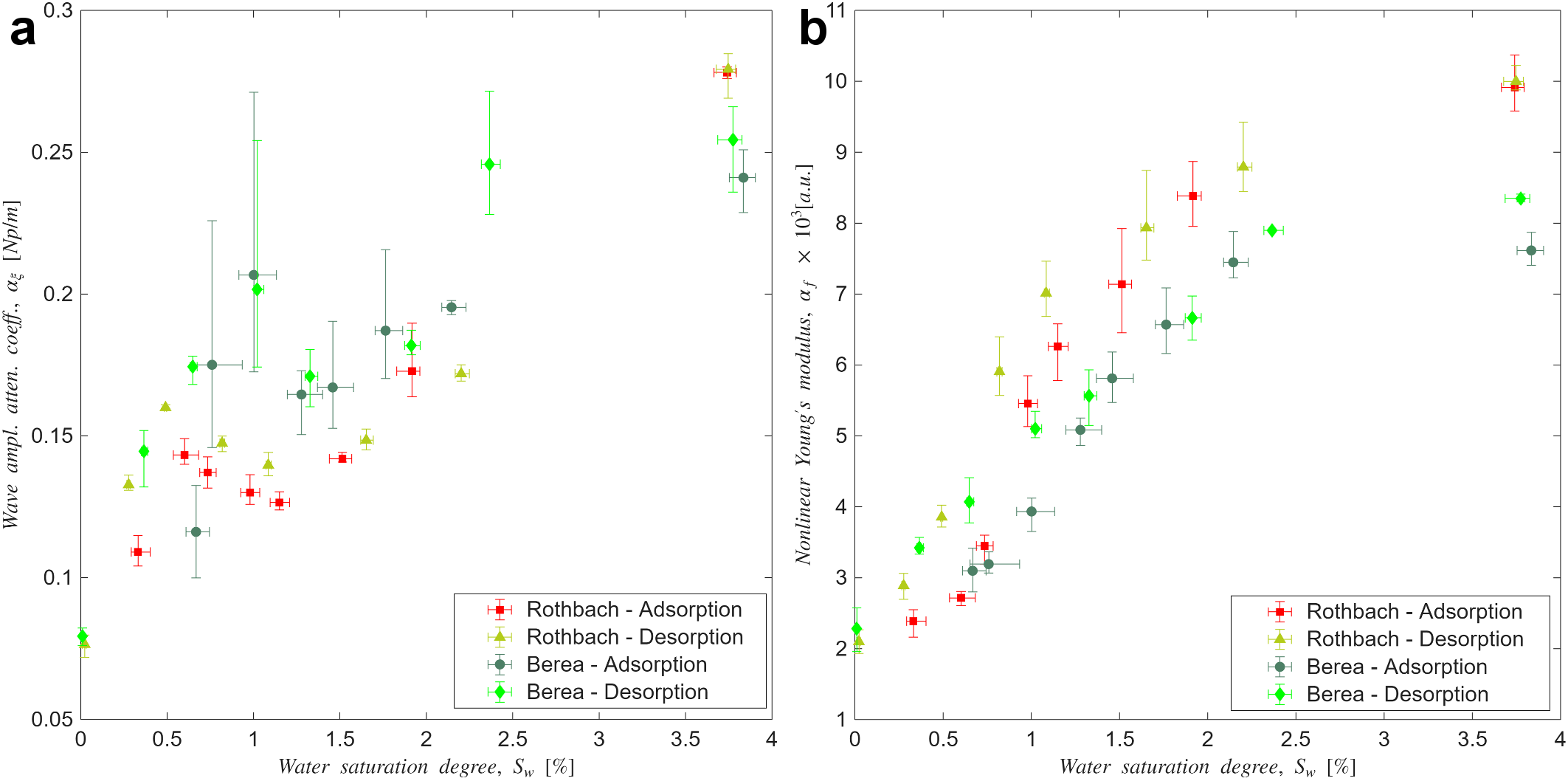 Speaker: Prof. Marco Scalerandi (DISAT, Condensed Matter Physics and Complex Systems Institute, Politecnico di Torino)
Speaker: Prof. Marco Scalerandi (DISAT, Condensed Matter Physics and Complex Systems Institute, Politecnico di Torino) -
14:35
Slow dynamics in saturated Bentheimer sandstone 35m
Rocks exhibit astonishing time dependent mechanical properties, like memory of experienced stress or slow dynamics, which refers to a transient recovery of stiffness after a softening induced by almost any type of loading. This softening and transient recovery is observed in the subsurface and in buildings after earthquake shaking, or in laboratory samples.
We investigate the anisotropy of nonlinear elastic behavior and slow dynamics in water-saturated Bentheimer sandstone subjected to 3 MPa of pore pressure, 5MPa of confining pressure, and different amplitudes of uniaxial strain. An array of P-wave transducers allows us to perform relative velocity change measurements for the duration of the whole experiment along different propagation angles.
We then fit our measurements to a simple model separating the velocity changes into angle-dependent classical nonlinear and nonclassical nonlinear components, and look into the uncertainties associated with our model parameters. Our results, compared with ones obtained in a dry setting, illuminate the complex interplay of pore fluids and excitation amplitude on the slow dynamics response of the material.
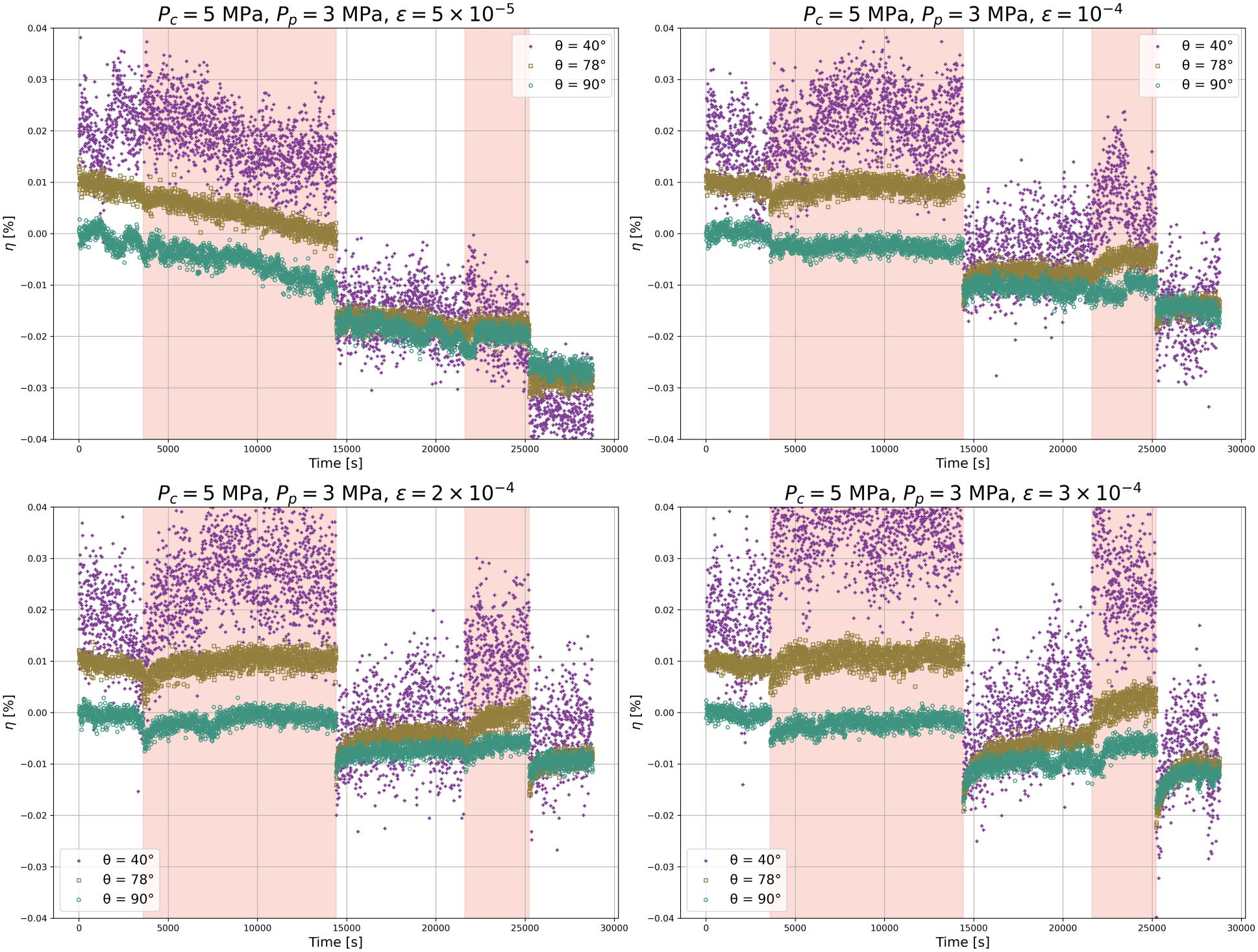 Speaker: Manuel Asnar (GFZ Helmholtz Centre for Geosciences, Freie Universität Berlin)
Speaker: Manuel Asnar (GFZ Helmholtz Centre for Geosciences, Freie Universität Berlin)
-
14:00
-
15:50
→
17:00
Time-dependent nonlinear effects: IV Aula
Aula
-
15:50
Predictable recovery rates in near-surface materials after earthquake damage 35m
Earthquakes induce transient mechanical damage in the subsurface, leading to postseismic hazards such as enhanced landsliding, with recovery often taking years to reach steady-state conditions. This behavior has been associated with relaxation, a phenomenon observed across a wide range of materials following strain perturbations. However, systematic controls on recovery duration in the shallow subsurface after seismic shaking remain poorly understood. Here, we investigate the successive impacts of two large earthquakes on subsurface properties by monitoring seismic velocity changes using ambient noise interferometry in the Atacama Desert, Chile. The hyperarid conditions of this region allow us to isolate mechanical effects by minimizing the influence of variable groundwater content. Our analysis reveals that relaxation timescales are governed by the intrinsic properties of the substrate rather than by ground-shaking intensity, suggesting that the subsurface's current mechanical state—not the earthquake's energy—determines recovery dynamics. These findings underscore the predictability of earthquake-induced damage evolution in the shallow Earth and potentially other materials. We reconcile this observation with existing physical frameworks by proposing a model based on the superposition of distinct populations of damaged contacts.
Speaker: Christoph Sens-Schönfelder (GFZ Helmholtz Centre for Geosciences) -
16:25
How does the impact magnitude affect the relaxation process in rock? 35m
The data from numerous laboratory and field experiments demonstrate that the material recovery processes in these two cases have much in common. In particular, they may take much longer than the impact (slow time), and the recovery is mostly (not exclusively) logarithmic. The main difference is in the duration of this time. A typical recovery time in laboratory experiments is of the order of minutes to hours, whereas for earthquakes it can take months and even years. Based on the thermodynamic (Arrhenius-type) model discussed earlier, this presentation considers the dependence of the effect on impact strength. It is shown that the dependence of structural changes on the impact strength can naturally explain a radical difference in recovery time, even at a moderate (a few times) variation of the effective contact volume. The statistical distribution of detached (metastable) contacts is accounted for.
Speaker: Lev Ostrovsky (University of Colorado, Boulder, USA)
-
15:50
-
18:00
→
19:00
Dinner 1h Speisesaal
Speisesaal
-
07:00
→
09:00
-
-
07:00
→
09:00
Breakfast 2h Speisesaal
Speisesaal
-
09:00
→
10:10
Geophysical observations: I Aula
Aula
-
09:00
Study on Post-seismic Slow Dynamic Recovery of Seismic Velocity in Tengchong Volcanic Area, Yunnan 35m
The Tengchong Volcanic Field (TCV), located in the southeastern margin of the Tibetan Plateau, is a large-scale active volcanic system. Geological surveys identify 68 Cenozoic volcanic centers distributed throughout the region. This volcanic system features extensive magma degassing, vigorous hydrothermal circulation, and intense volcanic and seismic activity, posing a potential threat of explosive eruptions. Therefore, investigating temporal variations in seismic velocity (dv/v) in the TCV helps reveal subsurface property changes and improves understanding of regional tectonic evolution. It also enables the detection of potential precursory signals of earthquakes or volcanic eruptions, providing critical scientific support for the forecasting and mitigation of geological hazards in the region.
We deploy 78 seismic stations across the Tengchong Volcano-Geothermal National Geopark and record multiple seismic events during the observation period. To monitor co-seismic velocity drops and post-seismic slow dynamic recovery, we apply the Coda Wave Interferometry (CWI) technique. The results show a significant reduction in seismic velocity immediately following earthquakes, followed by a gradual recovery over time. This phenomenon reflects a slow dynamic recovery process at the crustal scale, which closely relates to rock properties, regional tectonic settings, and source mechanisms(Johnson, 2006, TenCate, 2011, Sens-Schönfelder et al., 2018, Snieder et al., 2017). By projecting dv/v values onto a horizontal plane and combining them with surface wave tomography, we analyze the spatial distribution of velocity changes.
The results indicate that regions with stronger velocity perturbations are more sensitive to seismic events and tend to experience localized stress accumulation triggered by seismic shaking. In addition, subsurface heterogeneity leads to significant spatial variability in sensitivity to seismic perturbations. This spatial variation not only reveals the non-uniformity of the regional stress field but also provides additional constraints for fault zone imaging using tomography, thereby advancing our understanding of the dynamic evolution of regional tectonic structures.
references
Johnson, P., 2006. Nonequilibrium nonlinear dynamics in solids: State of the art, Universality of Nonclassical Nonlinearity: Applications to Non-Destructive Evaluations and Ultrasonic, 49-69.
Sens-Schönfelder, C., Snieder, R. & Li, X., 2018. A model for nonlinear elasticity in rocks based on friction of internal interfaces and contact aging, Geophysical Journal International, 216, 319-331.
Snieder, R., Sens-Schönfelder, C. & Wu, R., 2017. The time dependence of rock healing as a universal relaxation process, a tutorial, Geophysical Journal International, 208, 1-9.
TenCate, J.A., 2011. Slow dynamics of earth materials: An experimental overview, Pure and Applied Geophysics, 168, 2211-2219.
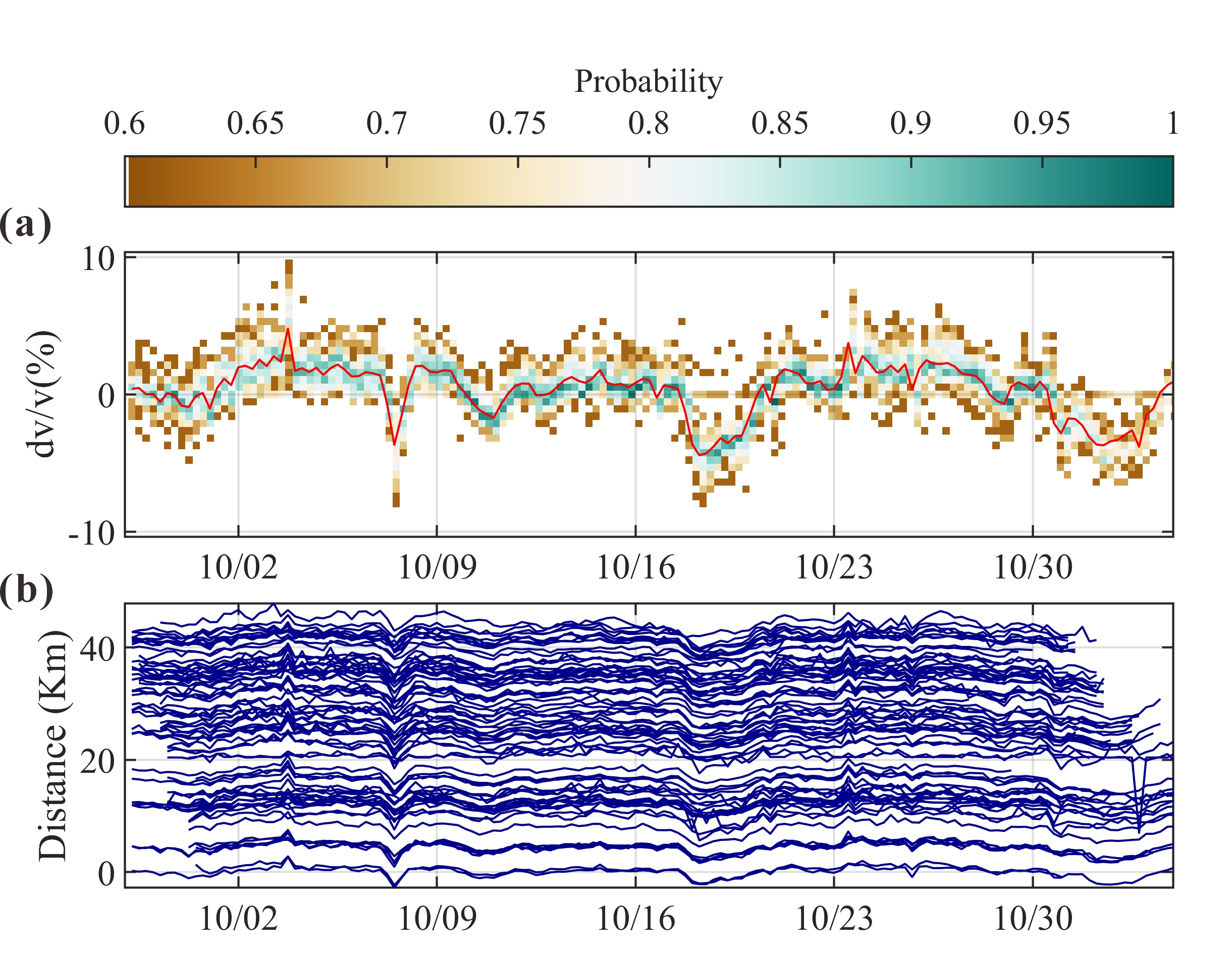 Speaker: Mr Xin Wang (Jilin University)
Speaker: Mr Xin Wang (Jilin University) -
09:35
Nonlinear response of rocks to strong shaking: observations, modelling, challenges 35m
Thanks to seismic interferometry, even tiny velocity changes in the subsurface following sizeable earthquakes can be detected with increasing spatial resolution. It remains a substantial challenge to forecast such velocity (or better elastic module) changes in a quantitative way. However, it is clear that such nonlinear behavior may considerably affect the ground shaking and thus needs to be accounted for if reliable forecasting of strong ground motion is desired. Here, we report on the addition of a specific nonlinear (damage) model to the wave and rupture simulation code seissol that is based on the discontinuous Galerkin method using tetrahedral meshes to discretize Earth’s structure and faults. The parameters of the nonlinear model are constrained by laboratory measurements. The numerical solution is applied to a realistic structure and rupture model of the 2015 Mw 7.83 Gorkha Earthquake in Nepal. The results show co-seismic velocity reductions up to 50% in a wide area around the fault with values affected by the existence of a sedimentary basin, varying with basin depth as well as fault slip distributions. The results suggest that such physics-based damage models should be considered not only for accurate estimations of strong ground shaking for earthquake scenarios but also when using observed motions to understand rupture processes.
Speaker: Heiner Igel (LMU Munich)
-
09:00
-
10:50
→
12:00
Geophysical observations: II Aula
Aula
-
10:50
Nonlinear elasticity in fault-zone and volcanic rocks 35m
The Physical Acoustics Lab has a 20-year history in studying both fundamental problems in wave propagation and applied research. The applied research has an emphasis on geophysics, where our experiments on rocks in the lab contribute to our understanding of geohazards including Whakaari, White Island and the Alpine Fault, New Zealand. More recently, our rock physics supports programmes in carbon and hydrogen geo-sequestration, as well as ventures in planetary geophysics. Beyond the geophysical applications, we have projects on non-destructive testing of fruit, ice, timber, and work on medical imaging. While this may appear as a widely varying set of problems, the underlying measurements have a common data acquisition system. In the physical acoustics lab we have developed a fully non-contacting laser ultrasonics setup, based on laser technology. We excite laser ultrasound with high-powered short-pulsed laser light, and detect the wavefield with laser Doppler vibrometry. The advantages of laser-based measurements over conventional contacting ultrasonic transducers include:
- There is no mechanical ringing in the source or receiver.
- There is no issue coupling source and receiver to the sample.
- Source and receiver can be placed independently with computer-controlled motorized stages.
- Source and receiver can access samples under hostile conditions, such as extreme temperatures and pressures.
Under this backdrop we have started a programme on nonlinear elasticity in the lab on different rock types. For these rocks, we investigate the elastic nonlinearity as a function of the temperatures and pressures experienced under in situ conditions.
In this presentation, we show laser-ultrasonic measurements on rocks from two of New Zealand's most prolific geologic features. First, we investigate the nonlinear elasticity of rocks in the damaged zone of the Alpine Fault of New Zealand's South Island. Second, we present similar measurements on rocks from Whakaari -- White Island, off the coast of the North Island of New Zealand.
For both samples, we have monitored the nonlinear elastic behaviour as a function of the temperature and pressure conditions representative of those expected for these rocks buried near the surface. Finally, we will discuss not only the implications from these measurements, but speculate about the effects of fluids on the nonlinear elasticity of such rocks.
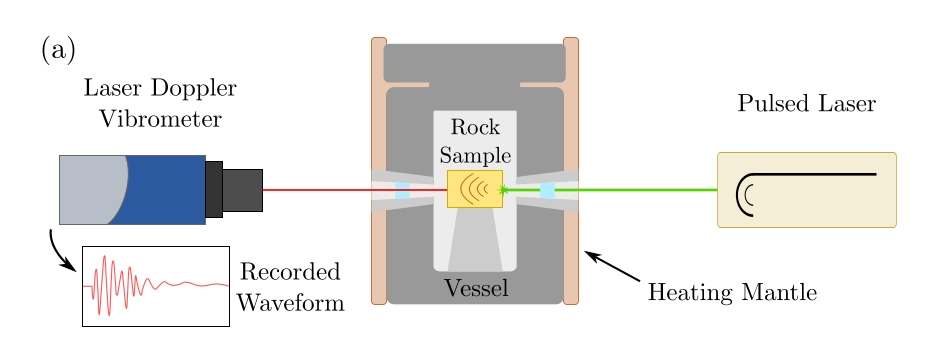 Speaker: Kasper van Wijk (Waipapa Taumata Rau, the University of Auckland)
Speaker: Kasper van Wijk (Waipapa Taumata Rau, the University of Auckland) -
11:25
Theoretical and observational results on damage related radiation 35m
Analytical results indicate that changes of elastic moduli in earthquake rupture zones produce damage-related-radiation (DRR) given by the product of the changes of elastic moduli and the elastic strain at the source. A tensorial decomposition indicates that the DRR has a large isotropic component expected to produce dynamic dilatation and enhanced P radiation. Since significant changes of elastic moduli during earthquake rupture occur in a small/narrow zone, the DRR involves primarily high frequency waves. The dynamic dilatation near the rupture front can significantly reduce the heat generation by the rupture, lead to pulse-type propagation, and produce rock fragmentation. Numerical simulations confirm these expectations. Analyses of seismograms recorded close to earthquake rupture zones reveal elevated P/S wave ratios and isotropic high frequency radiation consistent with the theoretical results. Geological studies of deeply exhumed faults in dry rocks show evidence of pulverization and delayed heating in earthquake rupture zones consistent with strong dynamic dilatation near the rupture fronts.
Speaker: Yehuda Ben-Zion (University of Southern California, Los Angeles, CA 90089-0740, USADepartment of Earth Sciences and Statewide California Earthquake Center, University of Southern California, Los Angeles, CA 90089-0740, USA)
-
10:50
-
12:15
→
13:15
Lunch 1h Speisesaal
Speisesaal
-
14:00
→
15:10
Instantaneous nonlinearity and NDT: I Aula
Aula
-
14:00
Investigating Coupled Flexural Mode Behavior Observed in NRUS Testing 35m
Nonlinear resonant ultrasound spectroscopy (NRUS) is typically performed using unidirectional testing methods where one type of mode is considered in the analysis. The mode types considered are longitudinal, torsional, or flexural modes, and the response is measured at a single location. In our experimental work, we have observed coupling behavior between longitudinal and flexural modes when exciting a Berea sandstone rod in the longitudinal direction.
The sandstone rod is excited with a piezo (PZT) ceramic disc at one end and measured using a 3D laser doppler vibrometer (LDV) along the top in the longitudinal direction, as shown in Figure 1a. Due to multidirectional displacement of the PZT, flexural modes are excited in addition to longitudinal modes. We measure the flexural modes in the transverse (Z) direction response FFT, shown in Figure 1b. While exciting in the longitudinal direction, the longitudinal modes exhibit nonlinear softening, but the bending modes exhibit nonlinear hardening. Due to the nonlinearity of sandstone, we expect coupled modes, but we will attempt to better understand the coupling.
We aim to study the behavior by predominately exciting the sandstone rod in each mode type, torsion, longitudinal, and flexural separately and seeing if the behavior shown in Figure 1b remains. Through the comparison, we will study if the coupling of the mode types provides better understanding of the overall nonlinear behavior of the material.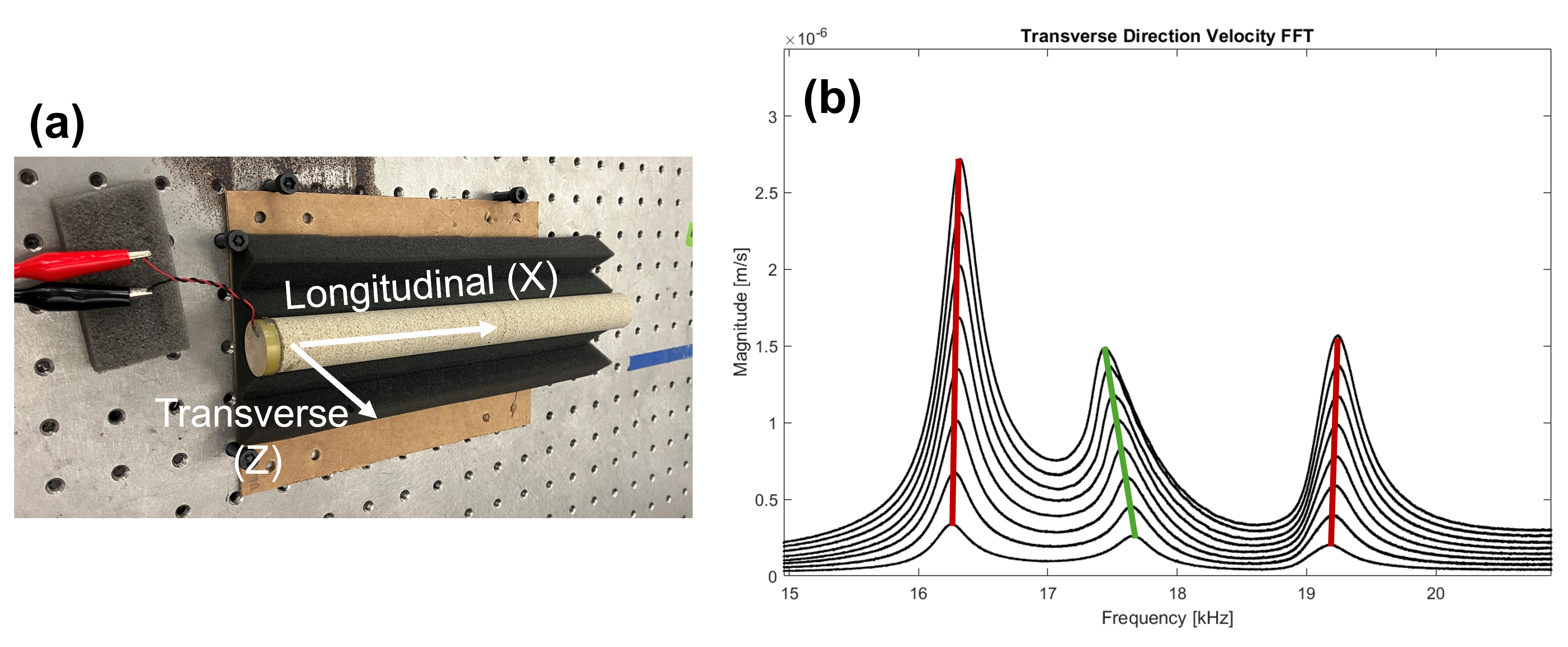 Speaker: Sarah Johnson (Texas A&M University)
Speaker: Sarah Johnson (Texas A&M University) -
14:35
Connecting linear and nonlinear ultrasonic responses of stressed fractured rock to fracture and bulk characteristics derived from in-situ synchrotron X-ray imaging 35m
The linear and nonlinear elastodynamic responses of fractured rock depend on bulk rock’s properties (e.g., porosity size and distribution) and fracture morphology (e.g., aperture, contact area, contact size distribution), which in turn controls the hydromechanical properties of the fractured rock. We conduct a series of coupled in-situ synchrotron X-ray imaging and through-transmission ultrasonic testing on intact and saw-cut Westerly granite and Berea sandstone samples to quantify the influence of bulk/fracture characteristics on the elastodynamic properties of fractured rock undergoing quasi-static and dynamic stresses. A subset of Westerly granite samples is thermally damaged by exposure to high temperatures (450oF, 850oF) without and with saw-cut fractures to simulate fractured rock with varying degrees of distributed bulk damage. The time-lapse ultrasonic data collected during quasi-static loading/unloading of the samples are analyzed to obtain the evolution of wave speed, amplitude and center frequency with increasing/decreasing stress. Three-dimensional X-ray computed tomography (CT) scans captured during quasi-static loading/unloading are analyzed to estimate the ‘true’ fracture contact area, contact size and aperture distribution as well as changes in bulk porosity. The ultrasonic data recorded continuously during dynamic stress oscillations are used to estimate the in-situ acoustic nonlinearity parameter β from the stress-dependency of wave speed and amplitude. A series of time-lapse 2D radiographic images captured during dynamic stress oscillations are analyzed to estimate the strain distribution in the bulk and opening/closing of the fracture. The stress-dependency of the ultrasonic attributes (wave speed, amplitude, frequency and β) is then evaluated in relation to the information gleaned from high resolution in-situ synchrotron X-ray imaging during quasi-static loading/unloading and dynamic oscillations. Our findings reveal a reciprocal relationship between the fracture aperture and the center frequency of the recorded ultrasonic response, which cannot be explained by the widely adopted displacement discontinuity model. We also find a strong correlation between transmitted wave amplitude and true contact area (and not the embracing area), which appears independent of the contact area distribution, in contrary to the existing literature based on very simplified experiments. The presence of a fracture influences the wave amplitude much more than the wave. Finally, both true contact area and contact size distribution appear to influence the acoustic nonlinearity parameter β; fractured rocks with smaller and more distributed contacts exhibit higher acoustic nonlinearities. These findings provide new insights into the interpretaion of ultrasonic attributes in relation to fracture properties with potential implications in inferring fractures’ characteristics from their seismic signatures.
Speaker: Parisa Shokouhi (Penn State)
-
14:00
-
15:30
→
16:00
Walk to the city center (Hetzelplatz / Tourist-Information) 30m start at monastery
start at monastery
-
16:00
→
17:00
Guided tour through the historic city 1h Hetzelplatz / Tourist-Information
Hetzelplatz / Tourist-Information
Neustadt an der Weinstrasse Hetzelplatz / Tourist-Information
-
07:00
→
09:00
-
-
07:00
→
09:00
Breakfast 2h Speisesaal
Speisesaal
-
09:00
→
10:10
Instantaneous nonlinearity and NDT: II Aula
Aula
-
09:00
Assessing Concrete Damage Using Thermal Modulation and Coda Wave Interferometry – preliminary results 35m
Thermal Modulation (TM) is a non-linear technique previously applied to homogeneous materials like steel and aluminium to detect changes caused by damage. While TM has also been tested on concrete (Sun, 2019), research remains limited, making it difficult to fully understand its potential, limitations, and scalability.
TM results can be influenced by several factors, including temperature range, rate of temperature change, humidity, cycle duration, temperature gradients, and material properties. Although tests on various parameters were conducted, this study presents preliminary results focused on one key factor: the water-to-cement (w/c) ratio in concrete.
Six concrete blocks were cast—three with a w/c ratio of 0.45 and three with a ratio of 0.50. Two of these (one from each group) were used as reference samples and kept under constant temperature and humidity conditions. The other four were subjected to increasing uniaxial compression, from 5% to 60% of their estimated maximum strength, in 5% increments. In between each loading step, the blocks underwent at least two 24-hour thermal cycles (from 10°C to 25°C) in a climate chamber set at 60% relative humidity.
During the thermal cycles, ultrasonic pulses were continuously recorded. These signals were used to calculate relative velocity changes (dv/v) via Coda Wave Interferometry (CWI). We then derived Thermal Modulation coefficients, which are known to correlate with damage levels from the dv/v and the internal temperature of the samples.
This experiment explores the combined capabilities of CWI and TM in detecting damage at different stages in concrete considering the material properties. A better understanding of how TM responds to variations in w/c ratio and damage progression helps to define the method’s applicability and limitations. These findings contribute as groundwork for future use of TM in the structural health monitoring of concrete structures.
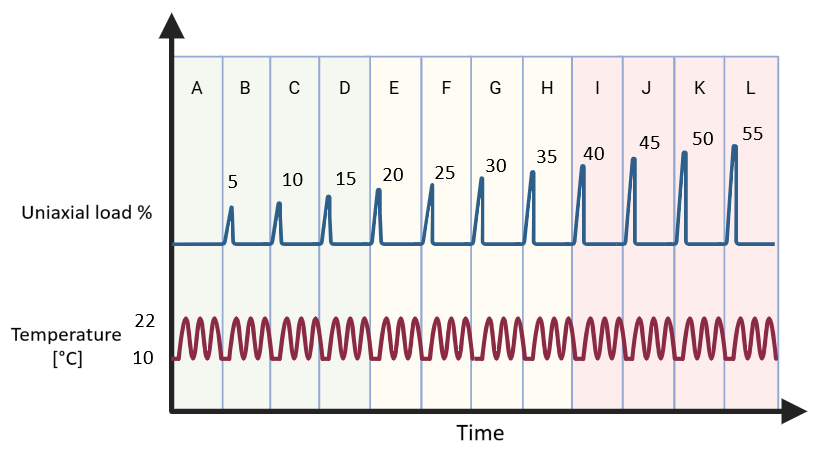 Speaker: Camila Andrea Sanchez Trujillo (BAM Bundesanstalt für Materialforschung und -prüfung)
Speaker: Camila Andrea Sanchez Trujillo (BAM Bundesanstalt für Materialforschung und -prüfung) -
09:35
Evidence of nonlinear acoustic behaviour in concrete constructions and the meso- and macro-scale 35m
It is known since long that concrete, including its reinforced and prestressed variants, shows nonlinear elastic behaviour on the meso (material) and macro (construction) scale. For about two decades scientist have made connections to nonlinear acoustic properties, mostly determined by ultrasonic measurements. The focus has been on coda wave interferometry and the so-called classic nonlinearity, e.g. an approximately linear dependence of ultrasonic velocity and stress. The practical application on a commercial scale is in preparation. However, there is more to it: Higher order nonlinearities, including slow dynamics, have been observed in lab experiments, but also at full scale models and real structures including bridges and a metro tunnel. The talk gives an overview of recent studies at BAM, the preliminary interpretation and the potential for exploitation.
Speaker: Dr Anna Sklodowska (BAM)
-
09:00
-
10:50
→
12:00
Instantaneous nonlinearity and NDT: III Aula
Aula
-
10:50
Stress- and time-dependent elastic properties in a test bridge model: from high to low frequencies 35m
Highly complex engineered materials, such as concrete, exhibit a systematic evolution of their elastic properties when subjected to the effects of static and dynamic loads. Such systematic evolution can be observed in phenomena like the acoustoelastic effect, when analysed as a function of stress, and in the slow dynamics—the fast softening and log-time relaxation processes—when examined as a function of time. The physical and theoretical description of such behaviour is rooted in nonlinear elasticity paradigms. Although the underlying physical mechanism responsible for this behaviour remains an open research area, it has been observed in laboratory experiments that such stress and time dependencies are majorly present in flawed materials. As a result, there is a growing interest in studying construction materials from the perspective of nonlinear elasticity for the development of damage assessment practices.
In this work, we investigate the time and stress dependence of the elastic properties of an outdoor-conditioned, two-span reinforced concrete test bridge across different temporal scales. We also explore the potential relationship between this behaviour and the physical state of the structure, with particular attention to the possible presence of imperfections. We monitored changes in the dynamic elastic properties on the bridge subjected to the effect of dynamic impulsive excitations superimposed on five different compressive forces using high-frequency embedded ultrasound sensors and low-frequency conventional seismic equipment.
The high-frequency data enable investigations into the stress dependency of impulsive-source-induced slow dynamics in concrete at four locations on the bridge using relative velocity changes and the energy content of the ultrasound signals. We observed that the elastic softening and relaxation processes are accompanied by energy dissipation, both of which occur at different magnitudes on both spans of the bridge. Those differences in magnitude are correlatable with ultrasound velocity values, which suggest relatively different integrity levels on both spans of the bridge.
The low-frequency data allow for the estimation of stress-dependent modulus changes of the fundamental standing wave of the bridge. We characterised this classical nonlinear effect using the acoustoelastic effect, and according to these results, subtle differences can be observed between the two spans of the bridge, which correspond to the results obtained from the high-frequency data.
This investigation led us to conclude that there is a relationship between nonlinear elastic phenomena and the relative integrity level of an in-situ concrete structure, allowing for the identification of soft microstructures within the concrete structure's composition, potentially affecting its performance.
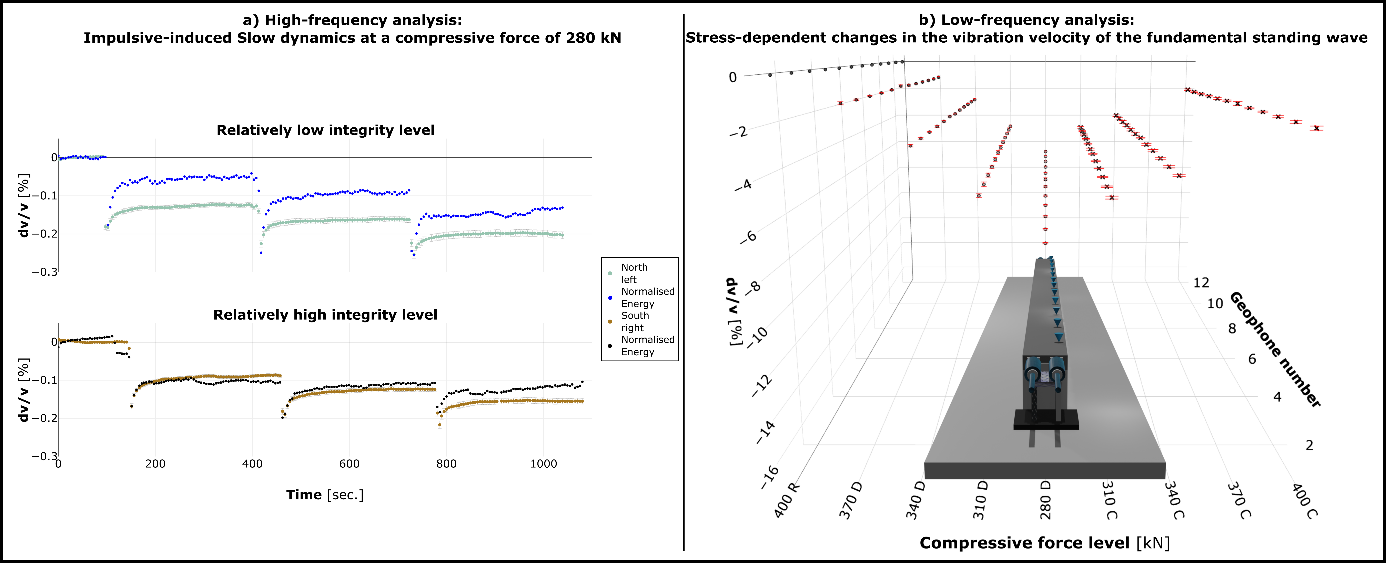 Speaker: Marco Dominguez-Bureos (Institute of Geophysics, University of Hamburg, Germany)
Speaker: Marco Dominguez-Bureos (Institute of Geophysics, University of Hamburg, Germany) -
11:25
Wave mixing in a heat-damaged concrete slab 35m
Characterizing the nonlinear mechanical properties of a superficial layer in a material using ultrasounds has applications in nondestructive evaluation. Among others, nonlinear ultrasonics has proven highly sensitive to heat damage in concrete. The common approach to achieve detection is to use the second harmonic generation effect, with Rayleigh waves. This effect is however of limited use if the medium if very attenuative or if there is significant scattering, which is the case of concrete at relevant scale of inspection.
We here choose to resort to the wave mixing phenomenon that converts two Rayleigh waves into a P-wave as a favorable alternative [1]. We propose to go beyond mere detection by looking for the signature of the depth scale of the damage – a preliminary step for inversion of a full depth distribution. For this purpose, we examine the frequency dependency of the effect, first numerically on a model distribution on Murnaghan’s parameters, and then experimentally. Our specimens are concrete and mortar slabs that have been exposed to elevated temperatures during a short time in order to generate controlled gradients of damage. By comparing with control specimens, we show that we do achieve detection of frequency dependence of the effect due to the damage gradient. Finally, we also demonstrate the effect and its frequency dependence on heat exposed steel plates.

[1] Gartsev, S., Zuo, P., Rjelka, M., Mayer, A., & Köhler, B. (2022). Nonlinear interaction of Rayleigh waves in isotropic materials: Numerical and experimental investigation. Ultrasonics, 122, 106664.
Speaker: Pierric Mora (GERS-GeoEND, Univ Gustave Eiffel)
-
10:50
-
12:15
→
13:15
Lunch 1h Speisesaal
Speisesaal
-
14:00
→
15:10
Instantaneous nonlinearity and NDT: IV Aula
Aula
-
14:00
Monitoring Reaction-Driven Cracking with nonlinear elasticity 35m
One method of CO2 sequestration is to react carbonated water with ultramafic rocks to form carbonate minerals. The formation of these minerals causes cracks in the samples, which increase the available surface area for the necessary reactions, making a positive feedback loop for Carbon storage. A key question about this type of sequestration is how to monitor the progression of the carbonation. We use five samples from two different locations (Bay of Islands Ophiolite deposit in western Newfoundland and The Cedars ultramafic suite in California) with different amounts of natural carbonate to investigate various monitoring methods. Some of the rocks were cut to make two samples (A and B in the figure). The amount of carbonate in each sample is determined using x-ray CT and thin section analysis. Because of the sensitivity of nonlinear wave interactions to cracks, one of the monitoring methods that we test is the magnitude of the nonlinear response of the rocks. We test this in two ways, the first uses solely propagating waves to mimic a relatively straightforward field experiment. The second uses Dynamic Acousto-Elasticity Measurements to assess the nonlinearity of each sample. The figure below shows our experimental setup for the propagating wave experiment as well as the results for the peak change in traveltime as a function of carbonate percentage. We interpret the clear trend with increasing carbonate content as an indicator that nonlinearity is a viable method to monitor this type of CO2 sequestration.

Acknowledgements: This work was funded by the Natural Sciences and Engineering Research Council of Canada, under the Discovery Grant programme.
Speaker: Alison Malcolm -
14:35
Evaluation of Plasticity-Induced Elastic Nonlinearity in Steel Using Nonlinear Guided Waves 35m
Non-destructively monitoring plasticity-induced microstructural changes in metals can provide valuable insights into structural integrity and enable early failure detection. Conventional ultrasonic methods often lack the sensitivity to detect such early-stage changes. Nonlinear ultrasonic techniques, particularly second harmonic generation using guided waves, offer enhanced sensitivity, making them well-suited for tracking microstructural evolution and identifying precursors of damage . In this study, we investigate the use of second harmonic generation of guided waves to evaluate elastic nonlinearity in steel subjected to progressive plastic deformation. A uniaxial tensile test is used to introduce homogenous microstructural changes within the gauge length of a plate type dog bone 304 steel specimen. Internally resonant guided wave mode pairs (S1–S2 and S2–S4) are excited and received at multiple locations within the gauge length to capture the cumulative effect of second harmonic amplitude. We will present the measured relative acoustic nonlinearity, β’, across different plastic strain levels and highlight trends observed in the second harmonic amplitude. The results will be discussed in the context of the sensitivity of second harmonic generation to evolving microstructure. This study will evaluate the feasibility of using guided wave second harmonic generation for detecting plasticity-driven changes in 304 steel and outline its potential for nondestructive material characterization.
 Speaker: Abishay Mohan (Delft University of Technology)
Speaker: Abishay Mohan (Delft University of Technology)
-
14:00
-
15:50
→
16:25
Instantaneous nonlinearity and NDT: V Aula
Aula
-
15:50
Tomographic-Holographic Acousto-Optic Imaging of the 3D Nonlinear Air-Coupled Emission Field of Delaminated Composites 35m
Defects in plates significantly affect the local propagation characteristics of ultrasonic guided waves. Specifically, crack-like defects can introduce various non-classical nonlinear wave responses due to clapping, friction and hysteretic effects. These phenomena not only introduce nonlinear elastic wave components into the plate, but also lead to the emission of nonlinear acoustic wave components into the surrounding air. Hence, airborne nonlinear emission analysis offers potential to detect and localize defects in the plate.
In this study, SLDV measurements have been performed using the acousto-
optic principle, i.e. the SLDV probes the air column above the plate, rather than the plate surface itself. In our approach, the SLDV scans a single line at a certain distance above the plate, capturing a 1D fan-beam projection of the nonlinear emission field. The plate is mounted on a rotation stage, and multiple fan-beam projections are recorded for various rotation angles. Using the concept of computed tomography, this set of 1D fan-beam projections is used to reconstruct a 2D cross-section of the nonlinear emission field. By coupling the tomo-graphic reconstruction to acoustic holography, a 3D volumetric representation of the nonlinear emission field is obtained.
Our results show that the developed tomographic-holographic methodology is able to convert 1D measurement data to a full 3D volumetric representation, even for nonlinear emission signals having low signal-to-noise ratio. Apart from getting a direct view on the presence and location of the defect, the proposed approach allows to get further insight on the elastic and acoustic radiation behavior of nonlinearly activated defects. Results are presented from both numerical and experimental datasets obtained on composites with delamination-like defects.Speaker: Mathias Kersemans (Mechanics of Materials and Structures (UGent-MMS), Department of Materials, Textiles and Chemical Engineering, Ghent University, 9052 Zwijnaarde, Belgium and FlandersMake@UGent – corelab MIRO, 3920 Lommel, Belgium)
-
15:50
-
16:25
→
17:15
Nonlinearity for environmental monitoring: I Aula
Aula
-
16:25
Rock Column non-linearity estimated from ambient seismic noise, acoustics, and environmental forcings 35m
The mechanical behavior of natural sites is largely guided by vibrations of the Earth and environmental exposure, but damage is rarely assessed, except empirically. Rock pillars , such as the Abraham's pillar above the Chauvet-Pont d’Arc cave, or the Tete Noire pillar overhanging the road to the Trient village (Wallis) represent shining example of fragility that would benefit from monitoring. Those rock columns extend out from the cliff like natural tuning forks. For this study, we monitored dancing movements of those pillar over several months to several years to analyze their elastic response to weather conditions. Using ambient-seismic-noise-based methods, we identified the pillar's natural resonance modes. Through extensive monitoring of the sites, we observed the striking temporal evolution of these resonance frequencies on hourly, daily, seasonal, and pluriannual scales in response to changes in air temperature and insolation. Based on thermo-acousto-elastic modeling with a simplified 3D geometric structure, we determined how thermally-induced stress stiffening affects the rock material, by applying convective and radiative heat fluxes to the model. From the results obtained, we suggest a novel quantitative method based on daily observations that can estimate the level of damage within the rock material. Our work provides a foundation for distinguishing between reversible processes and damage for hazard studies in the frame of climate change. Moreover, on a short time scale, we have investigated the role of rain and frost. Such knowledge is crucial not only for the preservation of heritage sites but also for enhancing risk assessment protocols and informing conservation efforts worldwide, and territories accessibility.
This work is partially funded by the European Research Council (ERC) under the grant agreement no. 101142154 (Crack The Rock) and the Horizon Europe MSCA Doctoral Network EnvSeis (grant agreement # 101073148).
Speaker: Eric LAROSE (ISTERRE-CNRS) -
17:00
Decennial Monitoring of the Séchilienne Landslide with Seismic Noise 15m
Landslides are difficult to predict and can therefore be a serious threat to populations and infrastructures. Understanding landslide processes and their precursor parameters is an important challenge for scientists and for public managers. Landslide monitoring is essential for determining the hazard associated with the unstable slopes. Computing seismic velocity changes from ambient seismic noise has been proven an effective tool for landslide monitoring. Before failure, a drop in rigidity in the landslide leads to a decrease in shear wave velocity, creating a potential precursory signal that can be retrieved by seismic interferometry (1).
An important step is distinguishing these precursory signals from environmental influences on seismic velocities, which are often observed. Seismic velocities can vary nonlinearly with stress and strain due to the behavior of fractured and unconsolidated slope materials. Small changes in external factors, such as groundwater level or temperature, can induce measurable changes in seismic velocity, potentially complicating the interpretation of precursory signals.
The Séchilienne landslide, located 25 km southeast of Grenoble, has been instrumented with broadband seismic stations since 2013 (2). We use this extensive dataset to compute relative seismic velocity changes from ambient seismic noise over a period of 10 years. We observe seasonal cycles (Figure 1) that could be caused by groundwater fluctuations inside the landslide. The seasonal cycles are best visible in low frequency ranges. Surface wave sensitivity kernels show these frequencies correspond to the lower part of the fractured layer of the landslide. No significant velocity drop was observed, which is coherent with no observed sudden acceleration within these 10 years.
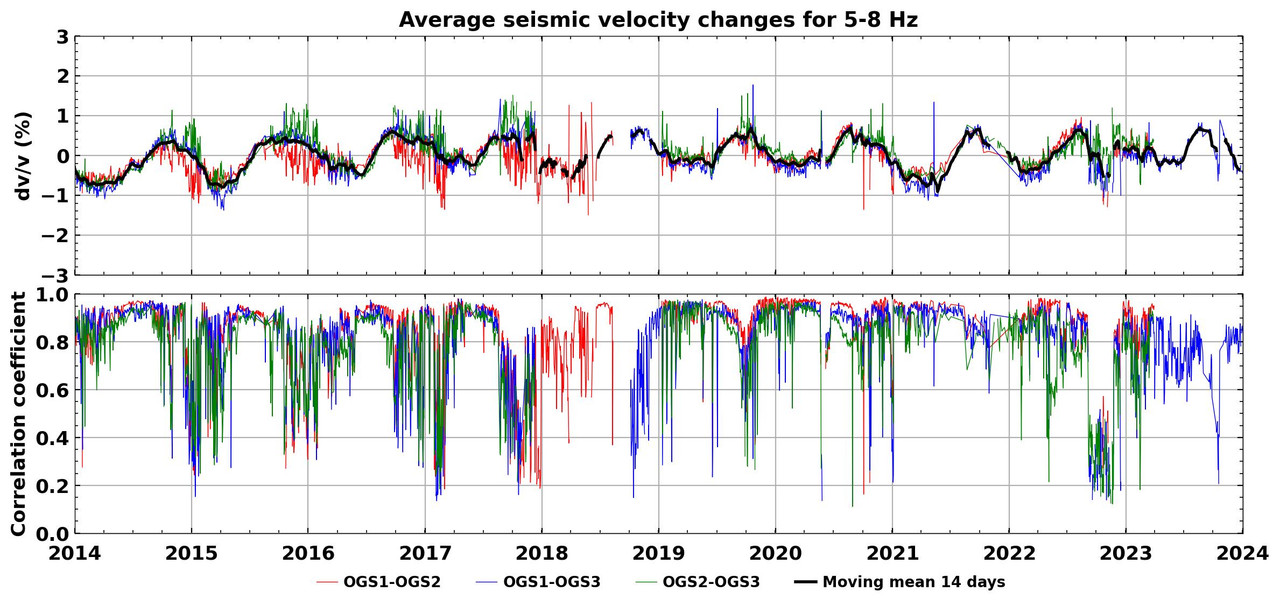
(1) Mainsant, G., E. Larose, C. Brönnimann, D. Jongmans, C. Michoud, and M. Jaboyedoff (2012), Ambient seismic noise monitoring of a clay landslide: Toward failure prediction, J. Geophys. Res., 117, F01030, doi:10.1029/2011JF002159.
(2) Seismic data have been acquired by the French National Landslide Observatory (OMIV), and are available at doi.org/10.15778/RESIF.FR and doi.org/10.15778/RESIF.MT
Speaker: Imme Wienk (ISTerre (CNRS), University Grenoble Alpes, Grenoble, France)
-
16:25
-
18:00
→
19:00
Dinner 1h Speisesaal
Speisesaal
-
07:00
→
09:00
-
-
07:00
→
09:00
Breakfast 2h Speisesaal
Speisesaal
-
09:00
→
10:10
Nonlinearity for environmental monitoring: II Aula
Aula
-
09:00
Ultrasonic Probing of Stress Changes in a Natural Cliff Undergoing Thermal and Frost Stress 35m
Rock fracturing plays a key role in shaping mountain landscapes and natural hazards. Weathering agents, such as daily thermal variations, rain and frost, are among the main triggers of the weathering and fracturing process. However, the mechanisms involved are not well quantified, and questions remain about stress variations in natural cliffs.
To better quantify the effect of thermal variations, periods of rain and frost on in situ mechanical properties at centimeter scale, field recordings were made using reproducible active ultrasonic sensors to measure both wave velocity and changes in wave form. The Abraham pillar above the Chauvet cave in southern France (Mediterranean climate) and the Tête Noire pillar in Wallis (Alpine climate) were equipped for periods ranging from several weeks to several months.
At the Abraham pillar site, thermal variations and rain events were studied. The results show a temporal evolution as daily cycles in velocity variation correlated with air temperature and solar radiation, while a significant drop in wave velocity after rain is revealed. At the Tête Noire pillar site, frost periods were studied. The results show a significant increase in wave velocity when temperatures fall below 0°C. Using thermo-acousto-elastic modelling, it is then possible to assess several in situ stress processes as a function of different weather conditions. Furthermore, ultrasound waveforms of both side reveal temporal variations, suggesting an evolution in micro-crack properties.

This work was funded by the European Research Council (ERC) under grant No. 101142154 - Crack The Rock projectSpeaker: Romain ROUSSEAU (ISTERRE-CNRS) -
09:35
On the use of the elastic lattice method to model nonlinear ground response at Mt. Etna, Italy 35m
Ground response (GR) refers to the ability of a field site to naturally amplify and damp seismic wavefield components under linear and/or nonlinear conditions. While seismic waves are typically the main triggers of GR, explosions and strong acoustic waves can also induce it through air-to-ground coupling. As both explosive sources and unconsolidated near-surface materials are common to find in volcanic environments, understanding GR becomes a critical task in volcanic hazard monitoring.
Previous studies have characterised the interaction between volcanic explosions and the loose granular scoria at Pizzi Deneri (PDC), an observatory site located 2.1 km northeast of Mt Etna’s summit craters. Infrasound sensors recorded high-frequency components (10–50 Hz) embedded in low-frequency explosion signals (0.7–4 Hz), which, upon coupling with the near-surface, were amplified as captured by broadband seismometers and Distributed Dynamic Strain Sensing data (DDSS). A nonlinear elastic model for the near-surface was derived from pressure rate vs. strain rate observations. However, the physical mechanism behind the observed high-frequency amplification remains unclear.
To investigate this, we employ the Elastic Lattice Method (ELM) to simulate wave propagation in the shallow scoria layer, modelled either as a linear or nonlinear medium using parameters derived from the nonlinear elastic model. Two source-time functions are tested: 1) a modified Shannon wavelet to test theoretical amplifications due to resonance, and 2) a real explosion waveform recorded in 2018 to replicate the observed GR events.
Our results indicate that horizontal-layer resonance cannot explain the observed GR behaviour. Instead, a nonlinear mechanical expression the layer might be required to reproduce the amplification. We discuss further in the potential variables to include in ELM to sharpen the nonlinear media modelling. These findings highlight the potential of ELM to model complex mechanical and wavefield responses in geomaterials and underscore the need to integrate GR and nonlinear effects into volcanic hazard assessments.Speaker: Sergio Diaz-Meza (GFZ Helmholtz-Zentrum für Geoforschung, Institute of Applied Geosciences, Technical University of Berlin (TU Berlin), Berlin, Germany)
-
09:00
-
10:40
→
12:10
Theoretical developments in nonlinear wave propagation: I Aula
Aula
-
10:40
Unexpected interaction between acoustic and weak shock waves 35m
In the middle of the last century, few theoretical studies have considered the case of the interaction between a shock wave and an acoustic one. Initially limited to 1D, following investigation have extended the problem to oblique interaction and have been of great interest for the stability of shock waves. However, development have been performed considering only perfect gases or strong shock wave (Mach number well above the unit) for most of them. The particular acoustic-acoustic interaction between a weak shock wave and a sound wave or even the interaction in solids for example have been scarcely investigated.
Recently, an experiment have been performed in those conditions. A shock wave and a counter-propagating acoustic one have been simultaneously generated in a single sample made of aluminum. The shock wave amplitude have been kept at a moderate level, below the Hugoniot elastic limit of the metal, corresponding to a Mach number close to 1,01. The two waves crossed each other in the medium and the acoustic wave is measured afterwards. Compared to a propagation in the absence of shock wave, a 10% decrease of its amplitude is identified that can only be attributed to the interaction with the shock wave.
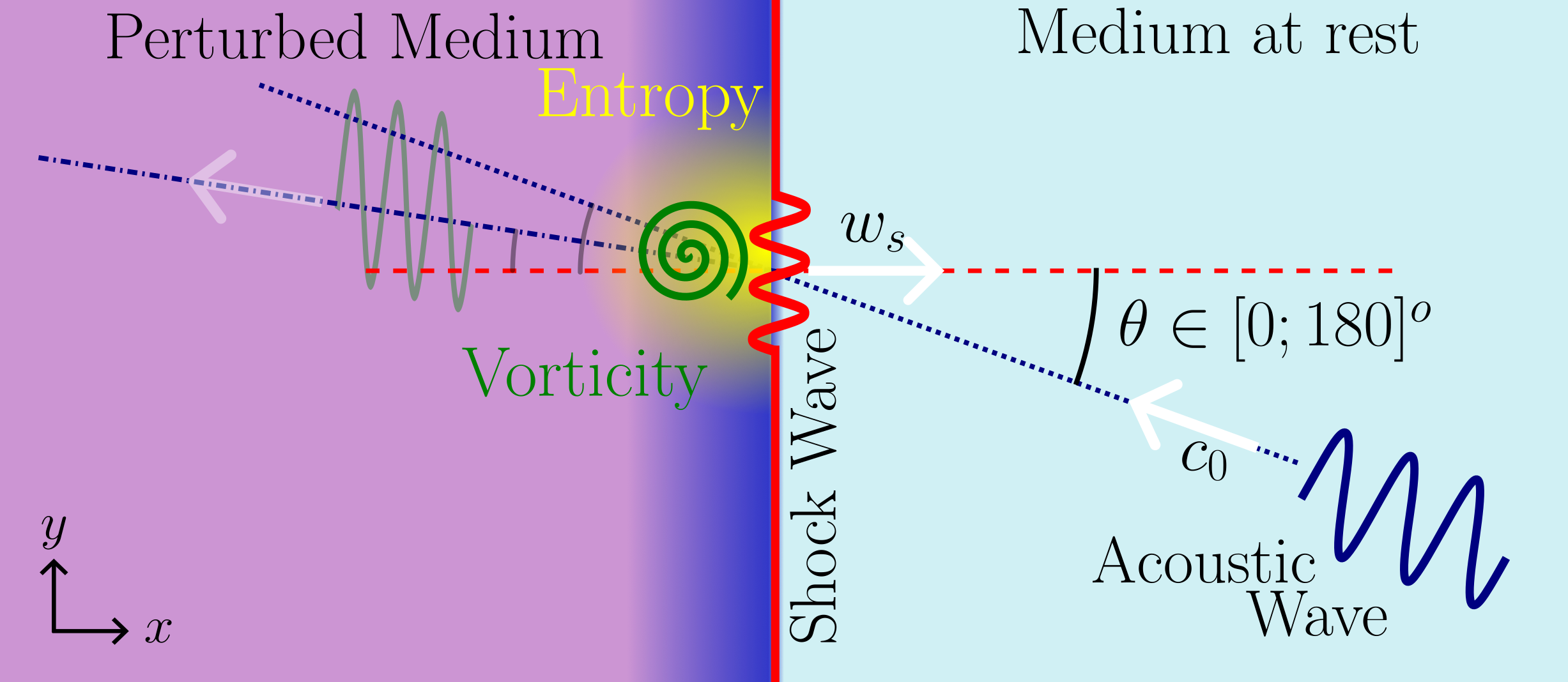
In order to investigate this curious observation, a nonlinear theory describing the encounter is developed, up to the third-order in shock magnitude. Considering a weak shock wave as well as an either co- or counter-propagating acoustic wave, their interaction leads to the generation of both an entropy and a vorticity mode in addition to the acoustic transmitted one. Perturbation of the shock wave as well as a Doppler effect are also taken into account. Resolving the Rankine-Hugoniot jump relations allow to identify the amplitude of all of the modes and of the perturbation. In case of a normal incidence, model is applicable to hyper-elastic solids and prediction agrees with previously mentioned experimental observations.
Speaker: Ronan Delalande (ENSAM) -
11:15
Second harmonic generation of acoustic waves in a nonlinear elastic solid 35m
Nonlinear ultrasound higher harmonics have become increasingly useful as a nonintrusive probe
of both microstructure as well as damage of solid materials [1]. The current theoretical underpinning
of these e orts rely on a formula for the second harmonic that is proportional to the square of the
linear wave and grows linearly with distance away from the source [2]. This formula holds only
for small distances, since otherwise there would be a violation of the conservation of energy. This
restriction is here lifted.
Consider the one-dimensional problem of wave propagation in a weakly nonlinear elastic solid
with a time harmonic loading of frequency localized at the origin, for a displacement u(x; t) as a
function of position x and time t on the whole real line. Using a successive approximation scheme
starting with the linear case, and a multiple time analysis, an explicit formula is found for the
second harmonic that is valid for all x [1]. The second harmonic so obtained is an amplitude-
modulated wave. As indicated in the gure, for small distances from the source the usual formula
found in the literature [2] is recovered.
Consequences of this result for non-destructive testing will be discussed.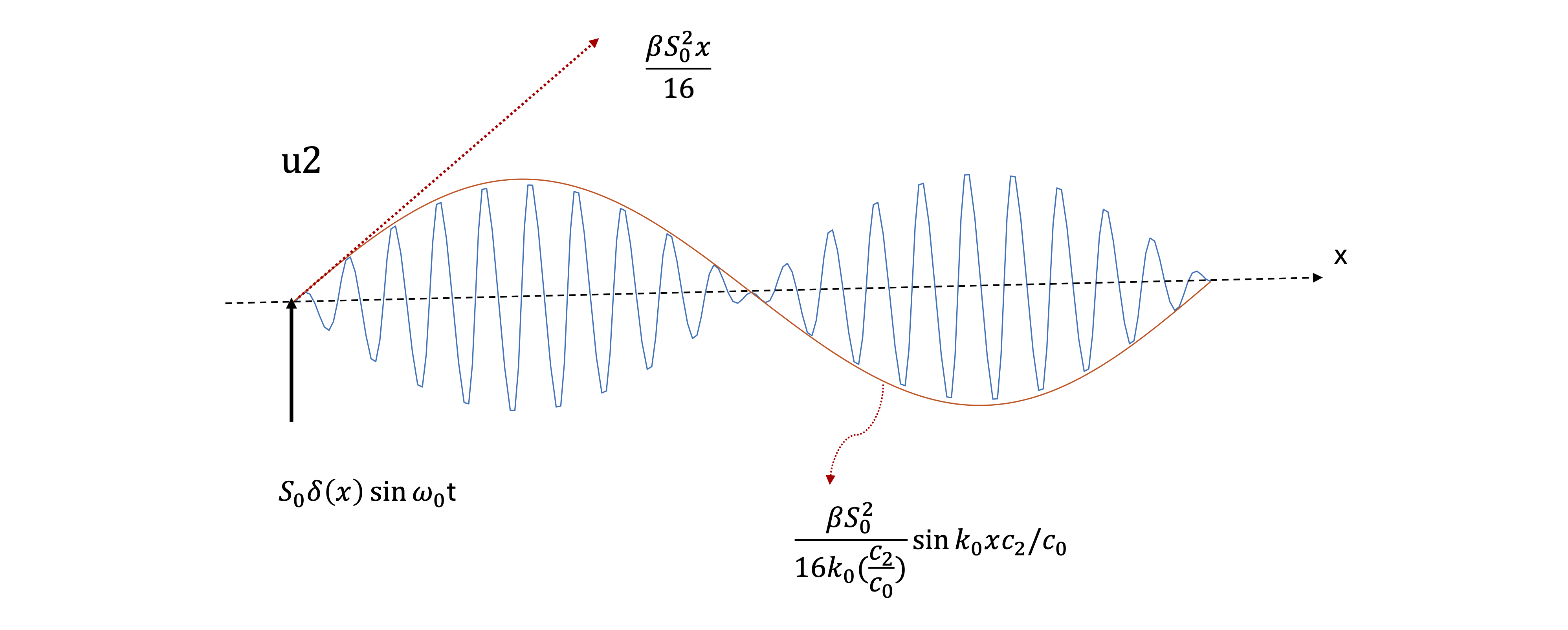
References
[1] F. Lund, Second and third harmonic generation of acoustic waves in a non-
linear elastic solid in one space dimension, J. Sound Vib. 600 (2025) 118895,
https://doi.org/10.1016/j.jsv.2024.118895 .
[2] C. M. Kube et al., A unifying model of weakly nonlinear elastic waves; large on large theory, J.
Acoust. Soc. Am. 151 (2022) 1294-1310, http://dx.doi.org/10.1121/10.0009101.Speaker: Fernando Lund (Universidad de Chile) -
11:50
Optimising Ultrasound-Based Physical Reservoir Computing with Nonlinear and Viscoelastic Media 20m
Physical reservoir computing (PRC) offers a promising path toward low-energy, brain-like computing by harnessing the inherent dynamics of physical systems. We present a novel ultrasound-based PRC system that exploits nonlinear acoustic wave propagation for classification tasks. As a proof of concept, we demonstrate performance comparable to state-of-the-art neural networks on a handwritten digit classification benchmark. These results highlight the potential of PRC to significantly reduce the energy and computational costs associated with training conventional neural networks. We investigate how key reservoir properties, nonlinearity, memory, and heterogeneity, influence performance through spatiotemporal wave transformations. Our results suggest that nonlinear and viscoelastic media, with intrinsic memory, can enhance reservoir dynamics, better suited for complex temporal tasks such as spoken digit recognition.
Speaker: Manfred Linton (University of Auckland)
-
10:40
-
12:15
→
13:15
Lunch 1h Speisesaal
Speisesaal
-
14:00
→
21:00
Excursion 7h start at monastery
start at monastery
-
07:00
→
09:00
-
-
07:00
→
09:00
Breakfast 2h Speisesaal
Speisesaal
-
09:00
→
09:35
Theoretical developments in nonlinear wave propagation: II Aula
Aula
-
09:00
Quadratically nonlinear wave interactions in fiber-reinforced materials with dissipative effects 35m
This paper investigates the interaction of weakly nonlinear waves in fiber-reinforced materials [1]. The constitutive relations consist of hyperelastic, polyconvex models incorporating a description that facilitates the modeling of mechanical dissipation. Models of this type can be used, for example, to describe membrane-shell structures made of textile materials or elastomeric bearings [2]
We analyze equations characterizing plane wave motion. The study focuses on quadratically nonlinear effects for shear plane waves. Using the method of weakly nonlinear asymptotics, the coupled evolution equations for the amplitudes of different pairs of waves are derived. It turns out that, in contrast to the isotropic case, quadratic nonlinear coupling is possible between shear waves in anisotropic solids [3,4]. We illustrate some properties by presenting numerical solutions for the evolution equations.
References
[1]Domański W., Franus A. (2025). Quadratically nonlinear interactions of shear elastic waves in fiber-reinforced orthotropic materials. Mathematics and Mechanics of Solids, 10812865251319246.[2]Franus A., Jemioło S., Domański W. (2025). Enrichment of fiber-reinforced material models with dissipative effects. Mathematics and Mechanics of Solids, 10812865241307663.
[3]Domański W., Jemioło S., Franus A. (2021). Propagation and interaction of weakly nonlinear plane waves in transversely isotropic elastic materials. Journal of Engineering Mathematics, 127(1), 8.
[4]Cormack J. M. (2021). Plane nonlinear shear wave propagation in transversely isotropic soft solids. The Journal of the Acoustical Society of America, 150(4), 2566-2576.
Speaker: Wlodzimierz Domanski (WAT)
-
09:00
-
09:35
→
10:10
Nonlinearity for reservoir characterisation: I Aula
Aula
-
09:35
Simulator-based Bayesian inference of enhanced geothermal reservoir properties 35m
Estimates of in-situ geothermal reservoir properties are essential for many scientific, operational, and regulatory purposes, including the controlling and managing of the potentially induced seismicity. We present first results of our research that combines results from a forward 3D viscoelastic damage rheology model (DRM) with a Bayesian Optimization with Likelihood-Free Inference (BOLFI) algorithm. We demonstrate the efficiency of this tool to invert for a wide range of structural and seismo-hydro-mechanical parameters supported by the DRM solver. The comparatively expensive forward calculations done with the Hydro-PED Finite-Element solver simulate hydro-mechanical interactions including the evolution of deformation, stress, rock damage, permeability, and fluid flow in response to the ambient conditions and the engineered overpressurization. Estimating the distributions of selected key parameters by comparing the results of the Hydro-PED model with observed, or here, synthetic, quantities is feasible because the machine learning BOLFI tool is a sample-efficient algorithm that minimizes the required iterations. In this work we set up a synthetic proof-of-concept case and infer the posterior distribution of the ambient stress conditions. We show that an arbitrarily chosen potency target function which encodes the spatial distribution of energy release within the reservoir produces more accurate results of the ambient principal stress values compared to a simpler event count target function. In our discussion we emphasize that the employed misfit function can be tailored to couple phenomena across multiple spatial and temporal scales observed during an hydraulic stimulation experiment. We discuss potential solutions to the computational challenges including GPU architectures and intermediate emulator stages that are advantageous to increase the resolution of the reservoir feedback processes. We conclude with an outlook on how simulator-based inference can be used to test and refine hypotheses on reservoir behavior before, during, and after stimulation for more effective EGS implementations.
Speaker: Gregor Hillers (University of Helsinki, Karlsruhe Institute of Technology)
-
09:35
-
10:40
→
11:50
Nonlinearity for reservoir characterisation Aula
Aula
-
10:40
Nonlinear Elasticity and Carbon Storage Site Containment Assurance 35m
Nonlinear time reversed focusing will be applied to map formation damage for the currently active progressive failure (PF) experiment in the Mont Terri underground rock laboratory (URL). This In-situ experiment monitors structurally-controlled rock mass deformation and damage. Complex shear failure occurs in the heavily instrumented 600 mm diameter micro tunnel, finding borehole breakout and complex fracture swarms controlled by bedding rather than stress anisotropy. Fractures and shear bands appear to self-heal away from the tunnel wall, possibly restoring original sealing capability to this caprock seal proxy for CO2 storage. Does this caprock fracture self-healing behavior help explain the lack of CO2 breach in Enhanced Oil Recovery (EOR) projects now in operation for over 50 years? Can nonlinear acoustics measures provide a means of quantifying these fracture healing attributes?
The NL measurements will be coupled to active measurements at the PF site that include photogrammetry, fiber optical strain sensing, seismic and electrical resistivity topographies.
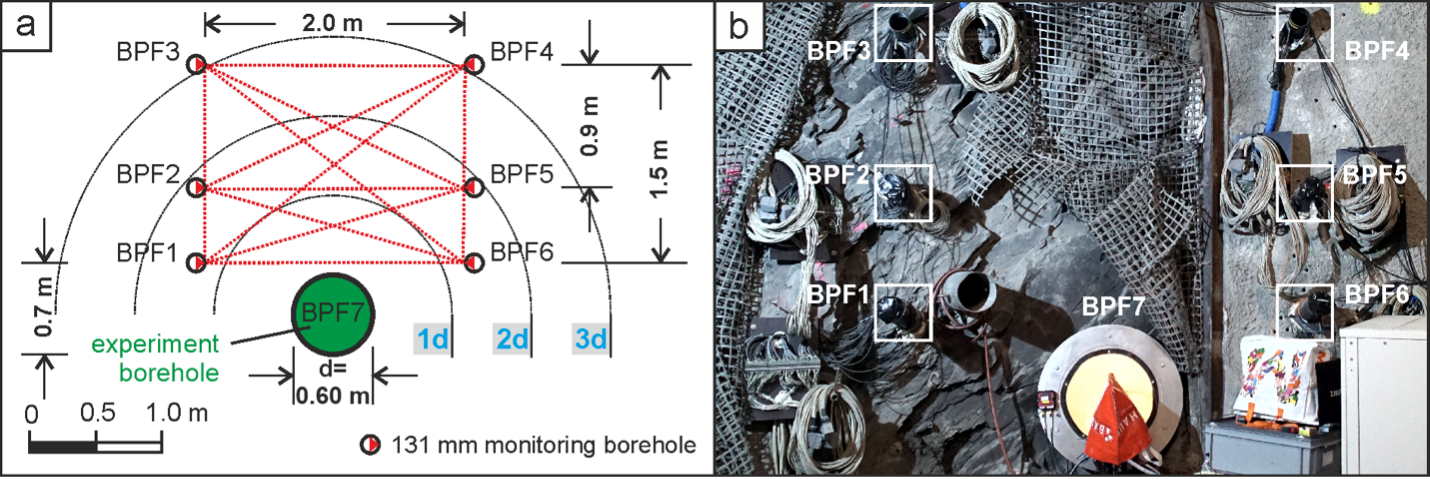 Speaker: Harvey Goodman (GOODMAN GEOMECHANICS LLC)
Speaker: Harvey Goodman (GOODMAN GEOMECHANICS LLC) -
11:15
Acoustic Landmine Detection: Nonlinear Mesoscopic Elastic Flexural Vibrations of Dry and Wetted Sand 35m
Plastic land mines are difficult to detect using conventional metal landmine detection methods. In airborne acoustic landmine detection, subwoofers located above the ground excite the soil (gravel) which couples into structural vibration of the buried “target.” The enhanced ground vibration can be measured remotely using a scanning laser Doppler vibrometer. Using nonlinear tuning curve results some false alarms due to soil inhomogeneous layering can be distinguished from the compliant vibration modes of the “top plate.” An understanding of mesoscopic nonlinear elastic behavior of granular material in flexural vibration with the compliant top plate is modeled using the SPO apparatus. Experiments using a soil-plate-oscillator (SPO) involve a vertical cylindrical column of unconsolidated granular medium (masonry sand, glass spheres, uncooked brown rice, uncooked milled oats, or even “Toasty Oats” ™ (dry cereal) that is supported by an air-backed thin circular elastic acrylic plate (4.5 inch diam and 1/8 inch thick) that is rigidly clamped between two thick-walled flanges. The soil column is driven from below 1) electrodynamically, using an AC coil & small rare earth magnet fastened on the plate’s underside, on center, or 2) acoustically, using a small 2 inch diameter loud speaker (4 ohms) located below the plate. A small accelerometer attached to the magnet is used to measure the vibration. An optical displacement sensor can also be used. In nonlinear tuning curve experiments the resonant frequency decreases with increased amplitude – representing a softening in the nonlinear system. The backbone curve (peak acceleration vs. corresponding resonant frequency) exhibits mesoscopic NL elastic behavior that can be modeled by a bilinear hysteresis force vs. displacement curve. For fixed amplitude, the resonant frequency vs. the granular medium mass loading (over the plate) reaches a minimum and then increases with increased loading due to the granular medium’s flexural stiffness – which overcomes the mass loading effects. For water loading, the frequency always decreases since there is no bending stiffness. Experimental results are compared for wetted vs. unwetted masonry sand.
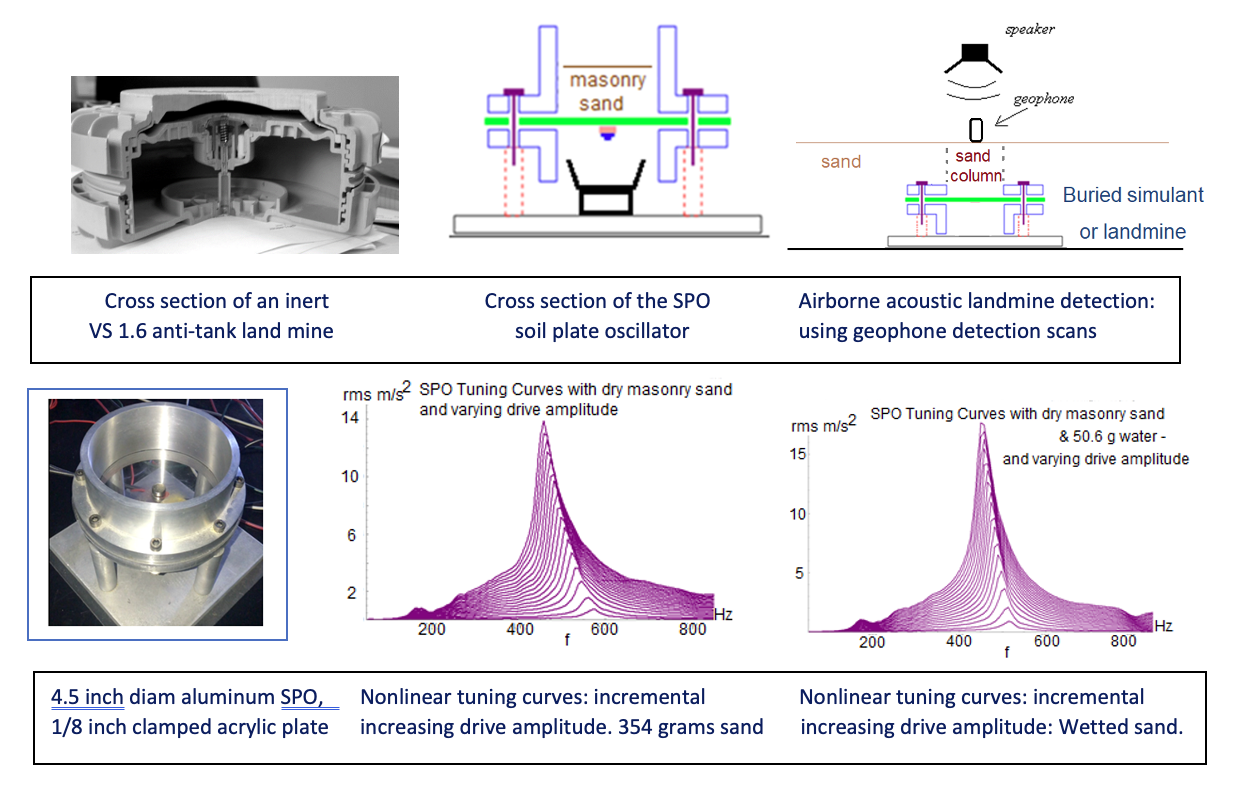 Speaker: Murray S. Korman (Department of Physics, United States Naval Academy, Annapolis, Maryland, USA)
Speaker: Murray S. Korman (Department of Physics, United States Naval Academy, Annapolis, Maryland, USA)
-
10:40
-
11:50
→
12:00
Conference closing Aula
Aula
-
12:15
→
13:15
Lunch 1h Speisesaal
Speisesaal
-
07:00
→
09:00
